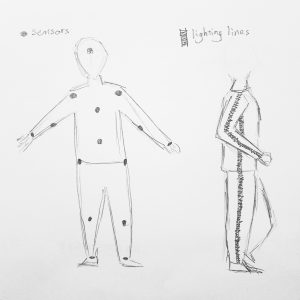Synchronization Suit
For the final project, I would like to make a synchronization suit that could assist people with needs of learning poses and moves. In general, it provides wearers with feedback of what part of body to move and where to move. Therefore, it could be helpful especially for performers needing to synchronize their moves.
A good example of how synchronization suit could be useful is learning a dance. As a dancer, I have been leading practices and teaching a dance routine for times, and it really takes me a lot of energy and time. If we could have a wearable tech that provides everyone in a team with feedback of how to move their body in ream time, it could improve whole team’s efficiency and save a lot of time. The idea was first inspired by the yoga learning helper mentioned in class discussion.
Functions
Following are tow main function modes of the suit I could imagine so far.
Real Time Feedback – Each sync suit could be set as a teacher or a learner. When set as learner, it receives signals from a suit set as teacher, and tells the wearer whether his or her moves is synchronized with the teacher. This mode should work when there are more than one suits.
Pre-Record Moves – When working alone, the suit allows the wearer to record a sequence of moves (ex. a dance, a fitness move-pattern) which could be later used to compare with moves of another wearer (either send to another suit or give the suit to another wearer). At the end of comparing, the suit would tell a sync rate to the user as result.

Implementation
Here are some choices I would have to make or difficulties I would face with making the suit.
How to collect data of teacher’s moves? – I think sensors that could collect information of position change would be very helpful in this case. To as clear as much draw the moves of teacher’s whole body, sensors would be placed at each key joint of human body (ex. wrist, elbow, shoulder, chest, crotch, knee).
Feedback should be provided in what ways? – As the wearer could potentially teach / learn numbers of poses and moves, the way of giving feedback should be simple enough and feedback should be easy enough to get no matter in what poses. So far the idea I have come up with is that there would be lighting lines along the side of arms and legs to work as the real time feedback giver. Whether the part of body is in the correct position would be shown in binary colors (ex. green for yes and red for no), and because the lighting lines are along the side of whole body, they already cover the largest space they could cover, which might be easy enough to see.
In what ways to tell wearer the position to move? – This would probably be the hardest part of making the suit. Should the guiding be told visually, or guiding should be transmitted physically through a light force on body? This is an important choice and should be considered and discussed further.
Other Thoughts
As colors are displayed based on whether moves are synchronized, this might be made use of in performing and creating a different visual experience.
Maybe choreographs or move patterns could be designed and edited in software and imported into the suit in the future.

